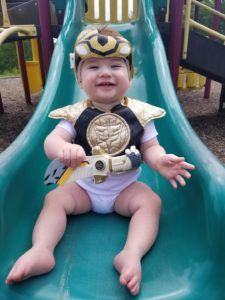Month: August 2019
I felt nervous, worried, apprehensive, but mostly curious. I was sitting in the orthotist’s office for her to complete a cranial scan on my son. He was 2 months-old and I was slightly overwhelmed. But I knew we were in good hands because Chris, one of the orthotists at Bioworks, is a professional with whom I have worked closely for over 5 years. And, as a pediatric physical therapist at ABC Pediatric Therapy Network, I was excited to be on the other side of this situation. I have referred several patient’s to Bioworks over the year for the same scan, and now it was my turn to experience it. I was excited to see what happened next.
This all started when my son, Knox, was born 2 months before. He and his twin sister were born just over 3 weeks early and spent time in the NICU. He was there for about 4 days. Once we were home, I started noticing he would typically only turn his head to the left. As a PT, I am always monitoring head position for possible torticollis, or neck tightness, especially in my own children. So, I started repositioning him and performing stretches. Despite this, by the time he was one month-old, I began to notice a flat spot on the left side of his head. I mentioned it to his doctor, who agreed but suggested we continue to monitor it. In the meantime, I continued my work with him at home and began checking with my insurance company on coverage for a cervical orthotisis (helmet).
By age 2 months, my son’s flat spot had gotten worse. He was turning his head more both directions, but continued to have an asymmetrical head shape. His pediatrician and I decided to pursue a helmet. We both knew that the earlier a child begins helmet therapy, the faster and better the results are. This is due to the fact that the baby’s head is growing the most in the first 4-6 months of life. Because of this, I wanted to start using a helmet as soon as possible, instead of waiting for him to possibly improve on his own and missing the best window of treatment in the meantime. This is how I found myself in the orthotist’s office a short time later in the unfamiliar position of patient/parent.
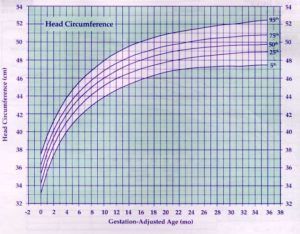
This US Pediatric CDC Growth Chart illustrates the rapid head growth occurring in the first months of life.
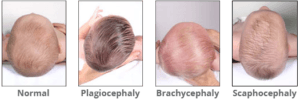
These pictures demonstrate some common head shapes that are often treated with helmet therapy (my son had plagiocephaly)
Picture courtesy of: www.cranialtech.com
The scan indicated a moderate asymmetry (plagiocephaly) and a helmet was recommended. I was happy because I knew we could start treatment early and make great progress. It ended up taking about 2 months to get all the insurance approvals and the helmet made and Knox started wearing his helmet at 4 months-old. Of course, I was concerned about how he would tolerate it, but I shouldn’t have worried. He hardly noticed it at all. He wore the helmet 23 hours a day with removal to bathe him and clean the helmet. He did everything in his helmet, including nursing, rolling over, tummy time… nothing changed or was diminished. The only downside was when he would sometimes get excited and bang his head into my collarbone when I was holding him – ouch!
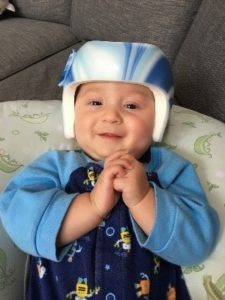
Happy baby in his helmet! He barely even noticed it. he is wearing the Boston Band https://www.bostonoandp.com/products/plagiocephaly/boston-band/
provided by Bioworks www.gobioworks.com
Because of the early intervention, Knox only had to wear his helmet for 2 months. At the time of discharge, he had improved his head shape from a significant asymmetry to only a very slight asymmetry. Now, at age 2, no one could ever tell he had a flat spot at all! I am so happy with the choice I made to pursue a helmet. The minor inconvenience for just 2 short months of his life made such a difference in the long run. I have always recommended to my patients’ families to pursue helmet treatment early if indicated and my own personal experience has solidified this to me.
If you have concerns about your child’s head shape, we can help! Go to http://www.abcpediatrictherapy.com to answer your developmental questions or for info on how to contact us.
Written by: Alyssa Taylor, PT, DPT
Read MoreImagine being in a room with no doors, but multiple windows on every wall. You try to shut one window so the breeze isn’t too strong, and two more windows open letting in birds chirping and someone else calling your name…you try to shut another window, but a new one opens with bright sunshine flooding the room. No matter how hard you try, new windows keep opening and distracting you with new information, that you just can’t filter out. This is the everyday life for person with ADHD.
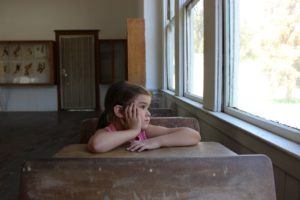
ADHD is a neurodevelopmental disorder affecting 15 million people in the US alone, with most of people being diagnosed in childhood. While medication can often be beneficial to living a successful and productive life with ADHD, new research suggests training kids in mindfulness can allow them to combat impulsivity, high energy levels, and attention to tasks, before and in addition to medications prescribed by your doctor.
Mindfulness training teaches kids meditation strategies, which include, but are not limited to: focusing on breathing, breaking tasks down into smaller steps to realize what truly must be focused on to complete that task, how to ground yourself when emotions take over, understanding what your child likes and dislike about having ADHD, and enabling the child to realize when they need help. Much like your muscles in your body, your neuro-pathways in your brain take lots of training and practice to get stronger. That’s why it is important to practice mindfulness during tasks that are most important to your child and your family. It can be for simple things like during household chores, bed time routines, how to cope with emotions, how to follow directions, making new and keeping friendships, whatever the needs are!
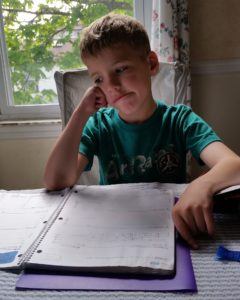
A great first step to work on is to just focus on taking breaths while keeping a still body. Try lying down with your child, with a pillow or stuff animal on your belly. Start for short time frames…can be as little at 10-30 seconds! Have your child place their hand on their belly, pillow, or animal friend, and state “all you have to do is breathe right now…in through your nose and out through your mouth…tell yourself you can control your thoughts and your body to stay still for this short time.” Once they are able to complete this step for a few minutes, have them try doing this while walking across a room telling your child “we are just walking and breathing…you can be in control of your thoughts and your body.” Once they master these skills in isolation, try some of the during your daily routine! Other supports like to do lists, post-it notes, calendars, and timers can beneficial to build time management and task completion. Mindfulness does not happen on its own naturally for children especially, so do not get discouraged if it takes some time for them to get the hang of it!
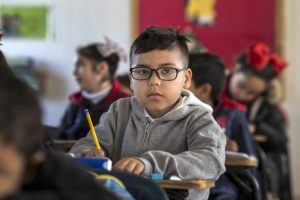
It’s important to remember that children with ADHD often get a lot of negative attention and often have strong feelings of worry, sadness, and embarrassment following their actions. Celebrate small victories and all the things that make your child unique, like their zealous for life, energy, and creativity! Ask your OTs for more mindfulness strategies you can use throughout the day!
If you have concerns about your child’s ability to focus, reach out to http://www.abcpediatrictherapy.com. We can help! Your child deserves it!
Information retrieved from:
Filling Your Toolbox with Techniques: Treating Children With ADHD
By: Amy M Schlessman, PT, DPT, DHS
Mindfulness for Kids with ADHD: Skills to Help Children Focus, Succeed in School, and Make Friends written by: Debra Burdick LCSW
Read More Skip to content
Skip to content
